Russia's Missile War Against Ukraine
This article is part of a larger research project on Russia's missile campaign against Ukraine. The comprehensive report will be released in September 2024. The German version of this article here: russlands_raketenkrieg_gegen_ukrainische_zivilisten.pdf
Supporting Ukraine in defending against Russia's attacks on its cities and infrastructure is essential. Russia's major air campaigns against civilian targets have destroyed 80% of electricity and two heat-producing facilities in Ukraine. The destruction has continued from night to night in recent weeks. The largest private electricity producer in Ukraine, DTEK, estimates that 90% of its power generation capacity was lost by late June and points out the impossibility to regain this capacity in the short term. Electricity imports from the EU are also severely limited, and building new power lines would take years. Power supply restrictions not only threaten the population's ability to maintain a civilized and reasonable life, but they also impede Ukraine's military defense capabilities by severely limiting the production of essential war goods. Russia has also continued to attack key components of civilian infrastructure like hostpitals. Only in July Russian missiles hit at least four hospitals, including Ukraine's largest children hospital Okhmatdyt in Kyiv. There is an urgent need for an action plan to comprehensively and quantitatively address the realistic requirements for air defense systems and ammunition. Failing to act or providing inadequate air defense equipment would not only jeopardize Ukraine's chances of survival but also send a disastrous political message to Russia that it can continue its air campaign unimpeded. Demonstrating Ukraine's ability to defend itself and end the war on its own terms is crucial for European unity. For Germany, a failed air defense could bolster populist, anti-Ukrainian forces advocating for reduced support costs. Additionally, it would signal to China and other revisionist regimes that while the West possesses advanced technology, it lacks the capacity to supply sufficient ammunition for warfare, undermining effective deterrence policy.
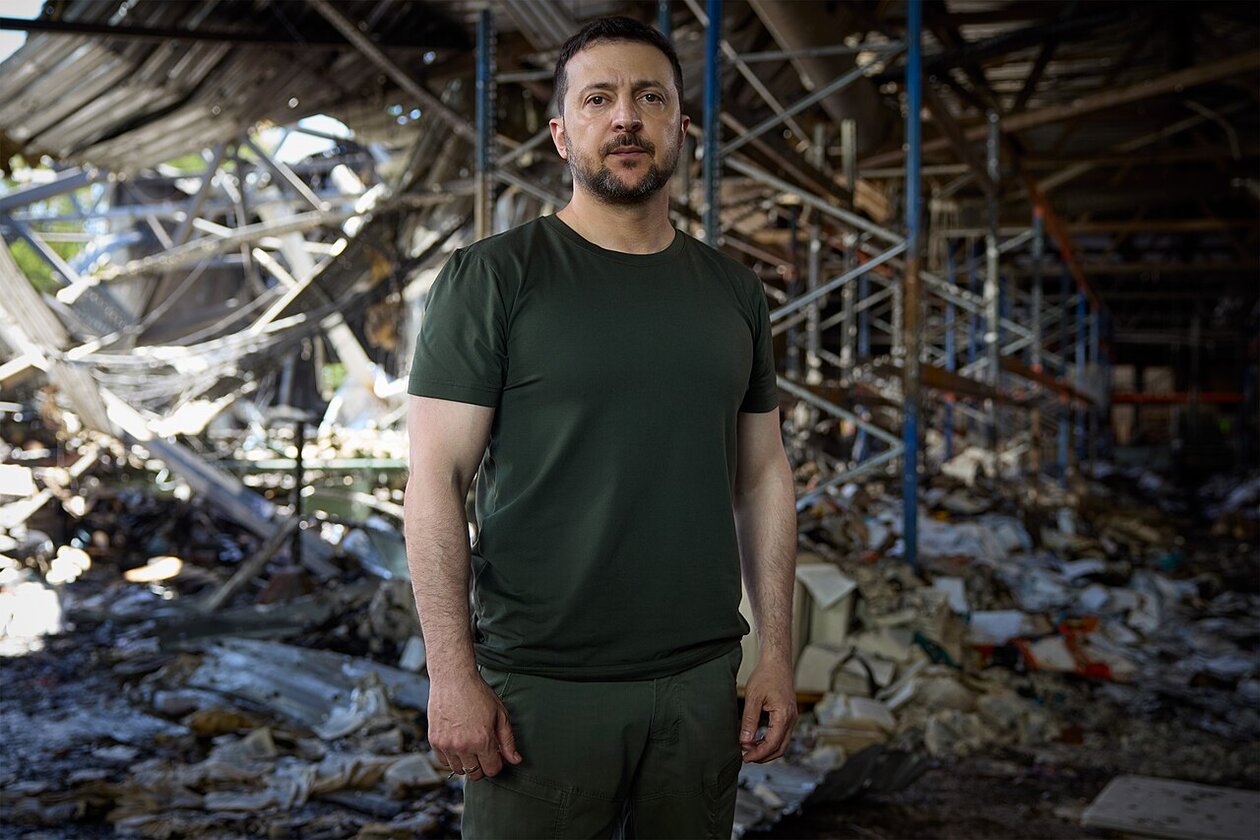
Ukraine's President Zelensky visiting Kharkiv after Russia's devastating strikes in April 2024. CC-zero President of Ukraine
Russian missile and drone attacks on Ukraine
This report analyzes all waves of attacks on civilian targets in Ukraine from September 2022 until July 2024, with a particular focus cruise, ballistic missiles and drones. The evaluation shows a significant increase in the waves of attacks and the number of individual Russian cruise missiles, rockets and drones targeting civilian areas in 2024. In the first half of 2024, approximately 3,500 ballistic missiles, cruise missiles, and drones were fired at Ukraine, double the number compared to the first half of 2023, with the highest numbers in January (620) and March (over 880 airstrikes).
Since the start of the air campaign against Ukraine in September 2022, Russia has continually adapted its tactics. The intervals between attack waves have steadily decreased since then, reducing the intensity of each wave. In summer 2023, the number of attacks on Ukraine's strategic infrastructure sharply declined due to the production of Russian missiles. Russia uses the summer months to replenish its missile stockpiles for larger, more intense attack campaigns in the fall and winter. We anticipate that Russia will continue this strategy in 2024. Attacks with cruise missiles and drones now make up the majority of Russian assaults, as this method effectively weakens Ukraine's air defenses.
Missiles or rockets with ballistic trajectories, such as the Iskander and Kinzhal, are more efficient and therefore more dangerous, but quantitatively, they play a smaller role in the two-year air campaign. Russia primarily relies on drones and cruise missiles to weaken Ukrainian air defenses. The strategy of switching from a few large to many small waves of attacks follows this logic: initial waves of cruise missiles act as scouts, followed by massive waves of cruise missiles and a few deadly ballistic missiles, overwhelming the Ukrainian air defense system. Missiles that fly at speeds over Mach 1, such as ballistic missiles and special cruise missiles like the Kh-22/32, remain particularly problematic due to their high speed and significant damage potential which, despite their inaccuracy, causes major destruction in urban areas. Russia is increasingly using more ballistic missiles, which reach very high speeds when approaching their targets.
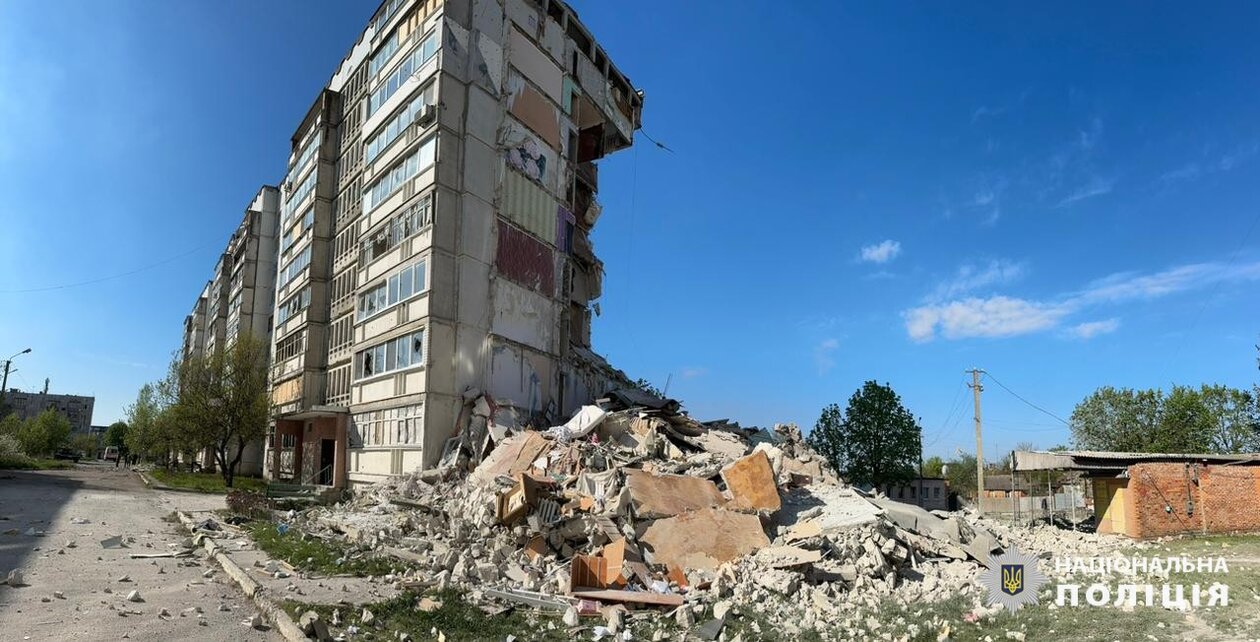
Destroyed residential area in Ukraine's Vovchansk, April 2024. Ukraine's National Police CC-BY-4.0
The Russian campaign of attrition peaked in March 2024, when Ukraine ran out of ammunition, and Russian cruise and ballistic missiles destroyed hydro-and coal-fired power plants. Russia's strategy aims to wear down the Ukrainian population by constantly restricting the power supply through attacks on energy infrastructure. This includes shutting down power generation and grids and the targeted destruction of heat generation plants in winter 2023-2024, what left parts of Ukraine without heating for extended periods. A failure of municipal heating plants could cause significant humanitarian crises in large Ukrainian cities if apartment blocks become uninhabitable due to frost and water damage. This scenario was averted in previous winters, but there is no guarantee for the next winter. In March 2024, as Ukraine ran out of ammunition and Russian missiles destroyed key power plants, Ukrainian power generation was reduced to 20% of its pre-war capacity. It remains uncertain whether power generation can be restored to ensure a minimum level of habitability in Ukraine's major cities by winter.
This year, Russia has targeted and destroyed school buildings, railroad facilities, museums, universities, and other educational institutions. Since summer 2023, attacks on agricultural infrastructure and port facilities in Odesa have persisted. The deliberate attack on the Okhmatdyt children's hospital in Kyiv on July 8, 2024, underscores Russia's intent to destroy Ukraine through such terrorist attacks. Bombing major Ukrainian cities like Kharkiv or Dnipro into uninhabitability, similar to the smaller cities in Donbas, would not only trigger significant new refugee movements but also severely challenge the overall functioning of Ukraine, especially in economic terms.
The Russian airstrikes have varying impacts on different regions and cities in Ukraine. The geographical distribution of the damage and targeted attacks also highlights the strengths and gaps in Ukraine's air defense. Developing an effective air defense system across regions, along with providing sufficient ammunition, is crucial for supporting Ukraine against Russia's air war. For example, the city of Kyiv was mentioned 10 times less often in daily reports in 2024, compared with 2023, due to improved Western air defense. In contrast, Kharkiv suffered more than any other city from airstrikes in 2024. In general, Russia is targeting regions with presumably inadequate air defenses more intensively.
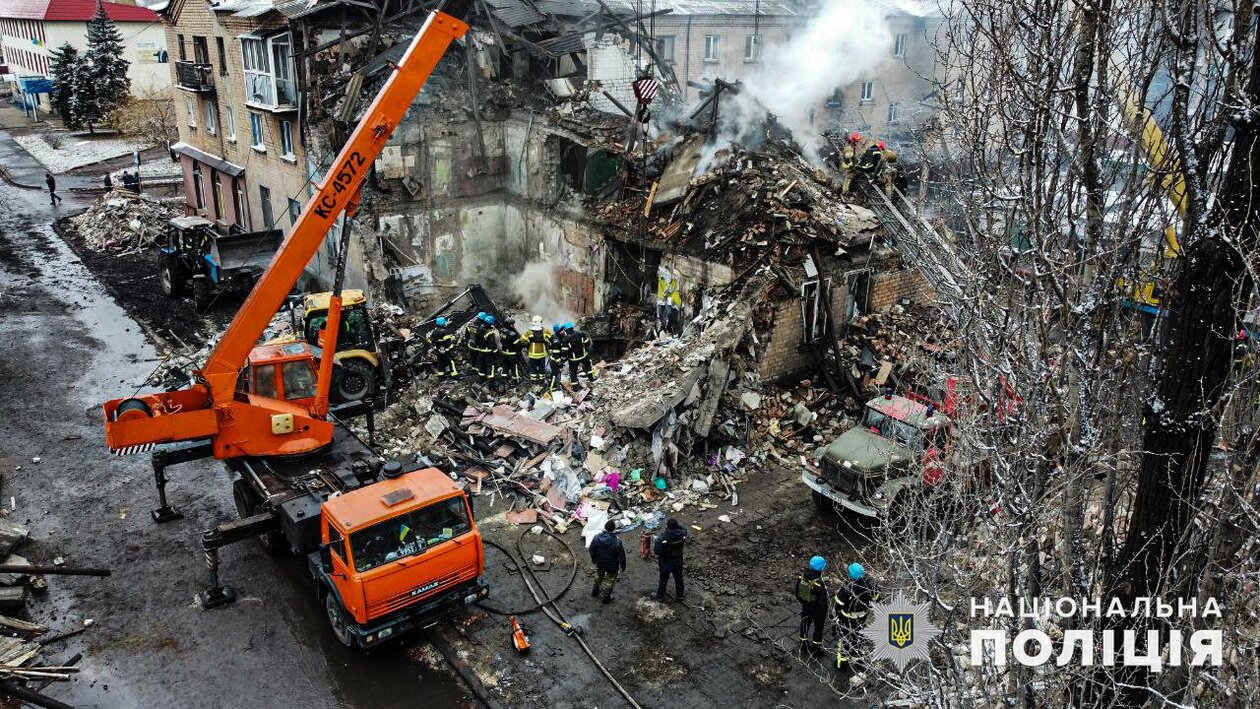
Ukraine's Novohrodivka, Donetsk region, hit by a Russian S-300 missile, 2023. Ukraine's National Police CC-BY-4.0
Another key objective of Russia's air war is to significantly disrupt Ukraine's defense industry by limiting its power supply. Producing ammunition and armored combat vehicles, along with their components, requires substantial energy. In 2023, the Ukrainian defense industry experienced significant growth, and its long-term strengthening is necessary due to the frequent interruptions in Western supplies. Ukrainian defense companies have managed to avoid major disruptions from direct hits through decentralization (distributing operations across various locations), structural hardening (producing in tunnels and bunkers), and redundancies (simultaneous production at multiple facilities). However, the power supply remains a critical vulnerability. As previously mentioned, the primary goal of the Russian attacks is the long-term depletion of Ukraine's air defense capabilities.
At the start of the war, the Ukrainian army had 32 S-300 batteries, 11 Buk-M1 batteries, and numerous short-range systems. These capabilities allowed Ukraine to protect most cities and critical infrastructure, such as power plants, substations, transportation hubs, air bases, the armaments industry, and ammunition depots. However, these Soviet-designed systems struggled to intercept ballistic missiles and high supersonic missiles, which were later used primarily for terrorist attacks against cities. The arrival of the first Iris-T battery in October 2022 and the first Patriot battery in April 2023 significantly enhanced the qualitative performance of Ukrainian air defense. However, the number of Western systems was too small to provide comprehensive protection against ballistic missiles, limiting this enhanced defense primarily to Kyiv. By spring 2023, Ukraine's ammunition stockpile for the Buk and S-300 systems was already critically low.
Ukraine entered the winter of 2023-2024 with three Patriot batteries, one SAMP/T battery, four IRIS-T, four NASAMS, and three HAWK batteries, totaling 15 batteries. However, these 15 batteries did not equate to protecting 15 individual targets. The necessity of changing positions, shifting fire control radars—whose locations could be detected via radio direction finders—and accounting for replacement systems all had to be considered. Germany's decision to provide more TRML-4D radars than Iris-T batteries was crucial, as it allowed for alternate operation of the radars. Another tactical advantage of the Iris-T and the American-Norwegian NASAMS is their design compatibility with Patriot systems, what enables them to complement each other when protecting a target.

U.S. Army's Patriot Air Defense battery in Poland. Photo: Sgt. 1st Class Christopher Smith
Ukrainian Air Defense: Interception Rates and Challenges
Ukraine’s drone interception rates are notably higher than those for cruise missiles. Last year, drones had an average interception rate of 80%, while cruise missiles were at 70%. These rates fluctuate significantly with each attack wave, especially for cruise missiles. In 2024, drone interception rates remained impressively high at 80-95%, and even improved throughout the year. The Ukrainian armed forces have made substantial progress in defending against Iran-designed Shahed drones using improvised methods. Machine gun belts are set up in the drones' flight paths, and mobile groups with machine guns operate in the intermediate terrain to counter attacks. Ukraine has also upgraded old anti-aircraft guns with thermal imaging cameras and target data receivers as a cost-effective way to shoot down drones. This has resulted in consistently high success rates against drones, despite occasional shortages of ammunition and launchers.
In contrast, the interception rates for cruise and ballistic missiles have declined in 2024. While Ukraine intercepted over 80% of cruise missiles in September 2023, this rate dropped below 50% by March. This decline is attributed to critically low ammunition stocks in the Ukrainian air defense. Firing rates vary significantly by missile type. The Kh-101 cruise missile, the most frequently deployed in 2024, had an interception rate of over 70%, similar to Kalibr cruise missiles, both with a flight speed of about Mach 0.7. However, faster missiles like the Kh-22, which can reach speeds up to Mach 4.7, had an interception rate of less than 20%. Missiles and ballistic missiles with speeds over Mach 3 (such as the Kh-22/32, Kh-31, Kh-47, Zircon, and Iskander-M) remain challenging to intercept. Particularly, quasi-ballistic missiles like the Kalibre-M have an interception rate of less than 10%.
Examining the types of missiles causing the most damage in Ukraine in 2024 reveals a hierarchy of threat. Disregarding S-300 types deployed near the border, the Kh-101/555 class leads with around 110 successful attacks after a 75% interception rate. The quasi-ballistic Iskander-M follows with about 75 hits and an 8% interception rate. Next are the Kh-59/Kh-69 (45 hits, 65% rate) and Kh-22/32 (45 hits, 10% rate), with the Kh-47 Kinzhal hypersonic missile at 40 hits and a 22% interception rate. Fast-flying ballistic missiles can only be countered by systems like the Patriot or SAMP/T. Russia exploits this by targeting poorly protected locations.

Ukraine Support Group meeting. U.S. government
Front-adjacent regions, such as Kharkiv, face significant threats from S-300 missiles, originally designed for air defense. These missiles constitute a significant portion of the interception failures. Russia likely had over 8,000 S-300 missiles at the start if the full-scale invasion. Despite using over 3,000 of these missiles, it still has a large reserve to pressure frontline cities, such as Kharkiv. These missiles, with ranges of 75 to 350 km, are difficult to defend against due to their high speed and short emergence time. This threat mainly affects cities in the east and south, such as Kharkiv. Proximity to the front line exacerbates Russia’s strike threat. Glide bombs, dropped by bombers near the front, pose a significant problem for cities and regions in eastern Ukraine. Russia's air force, possessing 80,000 to 90,000 Soviet-era conventional free-fall bombs now equipped with various armament kits, uses them to hit targets from 40 to over 100 km away when released from high altitudes. Currently, Russia deploys 1,500 to 3,000 glide bombs monthly against Ukraine, systematically destroying Ukrainian defensive positions and targeting frontline and border cities. 2024 reports frequently mention Russia’s air force deliberate use of the "double tap missile strikes" tactic on cities, where a second missile targets the same location after the initial strike to harm rescue workers.
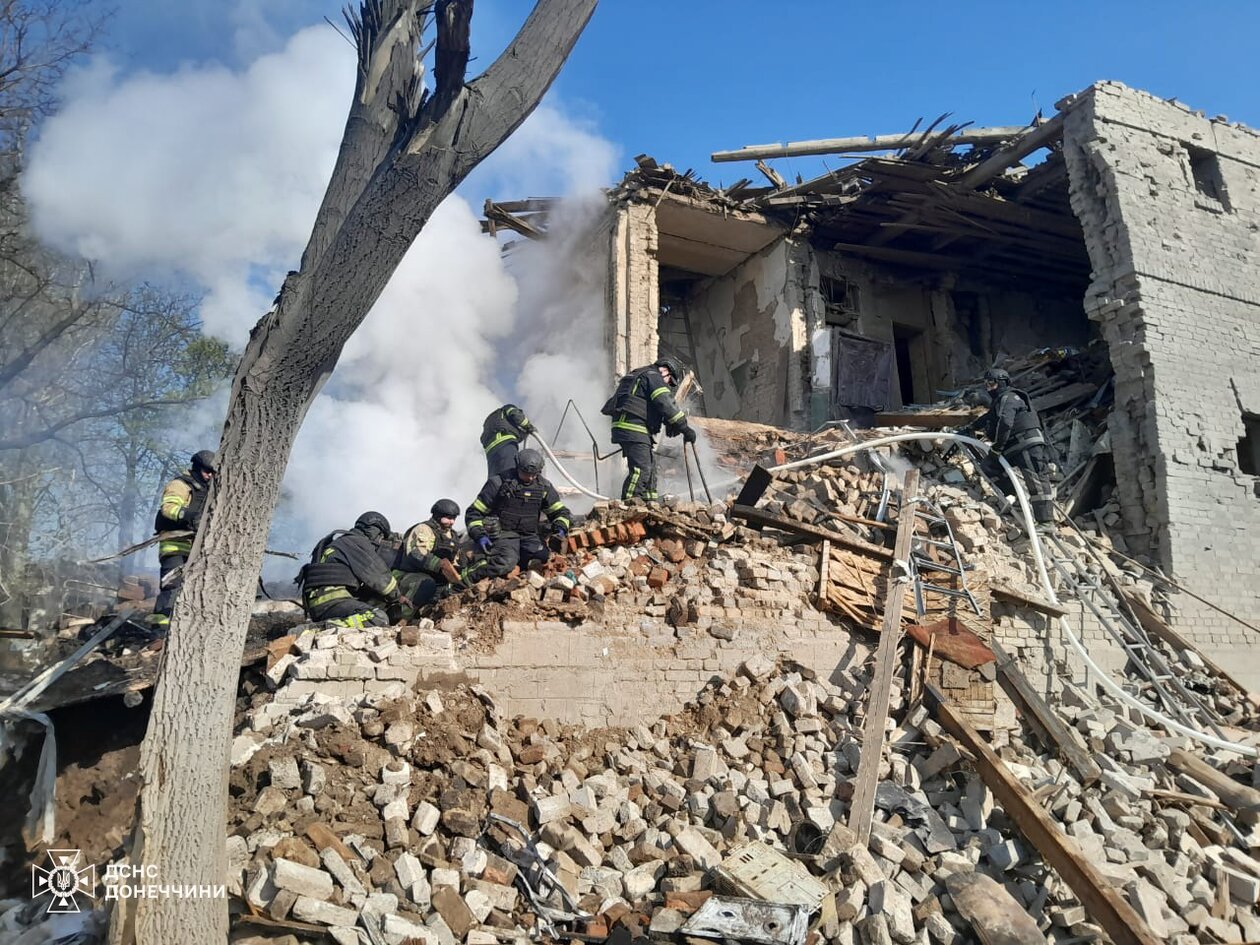
Ukraine's Konstyantynivka hit by Russian missiles. April 2024. Ukraine's National Emergency Service, CC-BY-4.0
Russia's production capabilities in 2024
In January, Colonel Yuriy Ihnat, spokesman for the Ukrainian air force, estimated that Russia had around 900 high-precision and long-range cruise missiles remaining. Vadym Skibitskyi, deputy head of the Ukrainian military intelligence service (GUR), provided details on monthly production figures. According to his reports, the primary threat consists of 115 to 130 strategically deployable missiles and cruise missiles with ranges over 350 km, which Russia can currently produce each month. While shorter-range cruise missiles lack strategic significance, they target air defense and frontline areas. Skibitskyi estimates the production of these shorter-range missiles at 100 to 115 per month, mainly because Russia does not rely on foreign components for their production, unlike the longer-range missiles.
By summing up Russian missile and rocket production figures used in its air campaign against Ukraine, the total reaches around 130 to 250, or even a nominal 300 units per month, including up to 50 ballistic and supersonic missiles. However, Russian missile production likely faces general problems due to sanctions on electronic components and damage to production facilities from Ukrainian attacks. Some short-range missiles are probably underused compared to their production rates, and launch options for Kalibr missiles remain limited. Russia can likely deploy over 200 missiles and cruise missiles per month from current production only under highly favorable conditions. The timing of the next major Russian campaign is uncertain. In 2022, the intensive phase began in October; in 2023 it started in late December. Scaling monthly production of Russian cruise and ballistic missiles with ranges over 350 km for the second half of 2024, including reserves accumulated until fall, suggests an expected monthly load of at least 200 cruise missiles and missiles over 3 to 4 months, possibly even 250 or more during a particularly intense two-month period. Subsequently, an average load of 150-180 attacks per month can be anticipated.
According to this projection, Ukraine could face a total of 1,200 air attacks over six months from fall 2024. This underscores the urgent need for better protection and sufficient ammunition, especially systems capable of intercepting ballistic missiles, even during the summer. A well-equipped air defense system with sufficient ammunition is essential. Assuming 12 interceptor missiles are required for every 10 attacks in a coordinated air defense system, approximately 1,500 interceptor missiles will be needed for six months of intensive bombardment. This calculation excludes drone attacks, which can be countered with simpler means. This total of 1,500 interceptor missiles includes around 500 rounds of special ammunition against hypersonic and ballistic missiles, with a range of over 350km. Quasi-ballistic missiles, which approach targets at high speeds and steep angles, are more problematic and often evade interception. Only the Patriot PAC-3 and Aster (the missile for SAMP/T) systems can counter these missiles with cross-thrust systems. Lockheed Martin has increased production of the Patriot PAC-3 from 350 to 500 missiles per year, while France has ordered around 200 Aster-15 and -30 missiles for 2024, although delivery will occur only in the coming years. If additional Iranian and North Korean missiles supplement Russian Iskander production, it could lead to shortages
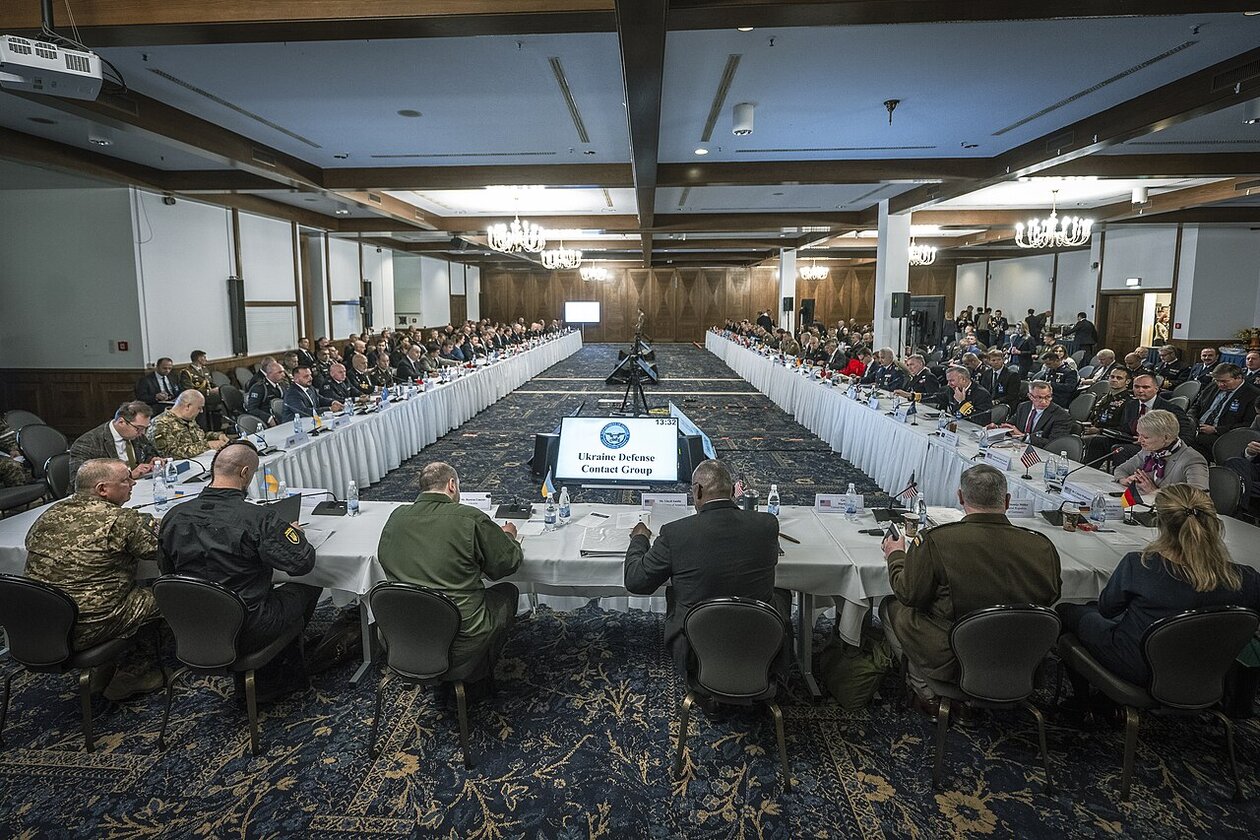
Ramstein meeting in 2023, public domain
Cruise missiles and drones account for the majority of Russian attacks. The Kh-101 cruise missile comprises 40% to 60% of attacks in the past two months and continues to pose a significant threat to Ukrainian air defense. Therefore, a substantial supply of ammunition for air defense batteries is required.
A more cost-effective solution involves better equipping the Ukrainian air force. Additional provision of combat aircraft such as the F-16 is crucial. More extensive equipment with air defense systems could also significantly reduce the threat of continuous bomb, missile, and drone attacks in eastern Ukraine. However, given Ukraine's large size and numerous important targets, ground-based air defense alone is insufficient. Interceptors could effectively target Shahed drones and Kh-101 cruise missiles if already airborne during intrusions. To maintain a squad (2 aircraft) in the air continuously, 24 aircraft are necessary. Considering Ukraine's size and attack frequency, about 80 fighter aircraft are needed to adequately protect its airspace. Currently, due to war losses, wear and tear, and ammunition shortages, Ukraine falls short of this requirement. Additionally, the promised F-16s made headlines due to delays.
To address the specific threat of ballistic and supersonic missiles, Ukraine must reduce the burden on Patriot and SAMP/T systems, essential for intercepting these and faster cruise missiles, to ensure its protection throughout the winter. Utilizing other systems like interceptors, Iris-T, and NASAMS for simpler targets can relieve the Ukrainian Patriots.
There remains the issue of S-300 missiles fired at very close range near the front, which are nearly impossible to intercept due to their speed and short flight time. A straightforward solution is to attack the launch bases directly. Since being granted permission to carry out such "defensive acts" on Russian territory in late May 2024, the Ukrainian army has successfully targeted these bases, leading to significant improvements, as seen in Kharkiv following the reversal of US policy. There were almost no attacks on the city afterwards.
Increased use of glide bombs near the front line in 2024, combined with ATACMS or other Western long-range weapons against Russian airfields, could effectively mitigate this threat. Moscow's challenge in replicating fighter aircraft means they are deployed in a risk-averse manner. The farther they are from the front, the more time Russian fighter-bombers spend flying in and out of the theater of operationals, resulting in fewer missions per day.
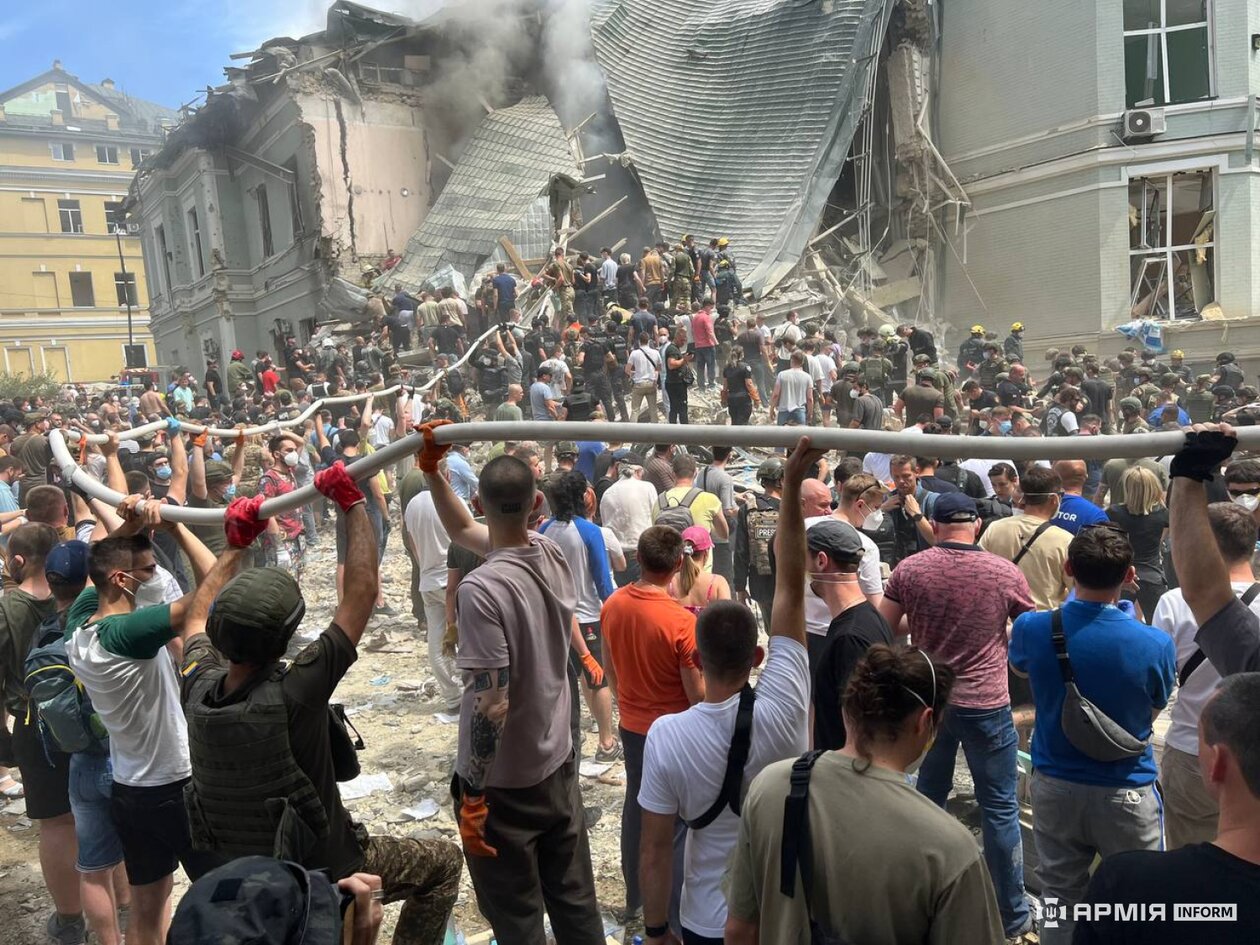
Ukraine's Okhmatdyt children hospital after a Russian strike in July 2024. ArmiyaInform CC-BY-4.0
Conclusion
Ukraine's air defense should now be significantly bolstered against Russia’s next air campaign. The current Russian production figures clearly indicate that the Russian air force has been preparing large-scale air attacks for the fall and winter. The crucial question is whether Ukraine's defenses will be adequately equipped by their partners in time to prevent the catastrophic destruction of their cities and infrastructure, as seen in the past two years.
The attack on the children's hospital in Kyiv underscores the urgent need to enhance Ukraine's air defense system. The debate on protecting Ukraine's cities has been misguidedly focused on individual systems. For instance, political leaders have limited their demands to ground-based air defenses or the delivery of F-16s. However, what is needed is an integrated system encompassing all levels of defense. This includes a substantial increase in the number of air defense systems, replacement radar systems, and most importantly, ammunition planning and deliveries tailored to real needs, along with the sufficient provision of fighter aircraft. The Saab 340 AEWs (Airborne Early Warning and Control System; AWACS) delivery from Sweden is a vital part of this expanded air defense capability.
Focusing solely on popular weapon systems like air defense batteries, which fulfil a purely defensive role and do not provide offensive advantages, misrepresents Ukraine's defense needs. Supporting front-line defense measures that can effectively keep Russian bomber squadrons at a distance and target the launch and take-off sites of Russian attack systems more comprehensively is crucial. Without these expanded military components and measures, major cities like Kharkiv and towns and villages near the front line will remain vulnerable to indiscriminate attacks with glide bombs and supersonic short-range missiles.